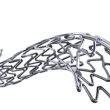Courtesy of Dr. Carlos Fava. Bicuspid aortic stenosis patients (bicuspid AS) represent a small group and have not been included in the larger transcatheter aortic valve replacement (TAVR) studies, since they present different morphology and asymmetric calcification, which might come along with more paravalvular leak and less accurate positioning. Between 2012 and 2016, 475,315 patients...
Drug Coated Balloons vs. Drug Eluting Stents in Primary PCI
There might come the time when we are finally able to leave nothing behind, at least in the context of primary PCI. The REVELATION study, soon to be published in J Am Coll Cardiol Intv, has shown that paclitaxel coated balloons resulted non inferior to drug eluting stents (DES) in terms of FFR (fractional flow...
Thin, Very Thin, and Ultrathin Struts, with Permanent or Biodegradable Polymer… Which Is the Best Combination?
Results from the BIO-RESORT trial at three years, soon to be published in JACC Intv., show that, despite significant differences among stents as regards strut thickness and capability to reabsorb the polymer, there are no apparent safety or efficacy differences among devices. The aim of this study was to determine the three-year safety and efficacy...
STEMI in Coronary Dissections. When Should We Do It and What Are Its Outcomes?
Courtesy of Dr. Carlos Fava. Generally, coronary artery dissection (SCAD) is not very frequent in young women and presents better evolution with medical treatment. However, it is occasionally associated with ST segment elevation. In this scenario, PCI with stent implantation is quite challenging. The study looked at 4298 STEMI patients; 53 presented SCAD (1.23%). STEMI-SCAD...
The Most Read Articles of August in solaci website
1-FDA Expands TAVR Indication to Low-Risk Patients Both the self-expandable valve Evolut R and its direct competitor, balloon-expandable valve Sapien 3, received the authorization to be indicated for low-risk patients in a long-awaited announcement made on August 16th, 2019. Read also HERE 2-Mechanisms of Post PCI Persistent Angina Angina persistence or recurrence after PCI can...
Should We Start Using the Retrograte Access in Critical Limb Ischemia?
Courtesy of Dr. Carlos Fava. Peripheral vascular disease in lower limbs is on the rise. Antegrade recanalization is associated with amputation and death, and therefore contraindicated. For a while we have been using the retrograde access when classic revascularization is not possible. Even though there is evidence in favor of this access, it is just...
The Real Impact of Peripheral Artery Disease in TAVR
Courtesy of Dr. Carlos Fava. The real incidence of peripheral artery (PAD) disease in TAVR remains unclear. Different reports still estimate it is between 10 and 46%, but they have shown it has a negative impact in evolution. 51,685 TAVR patients were analyzed. 12,740 of these patients presented PAD (24.6%). PAD patients tended to be...
Theoretical Advantages Translated into Worst Clinical Outcomes: Synergy vs. Xience
New data from a real-world registry soon to be published in J Am Coll Cardiol Intv suggest that Synergy (a thin-strut everolimus-eluting stent with a biodegradable polymer) is associated with a higher risk of acute stent thrombosis when compared with classic Xience (a thicker-strut everolimus-eluting stent with a durable polymer). At 12 months, there was...
ESC 2019 | CLARIFY: Symptoms Predict Risk Only in Patients with Prior MI
The 5-year follow up of patients with chronic stable angina (or as the guidelines currently call it “chronic coronary syndrome”) indicate the risk of cardiovascular death or non-fatal MI is quite low, but risk factor control is still fairly poor. This information comes from the CLARIFY study, presented at ESC 2019 and published simultaneously in...
ESC 2019 | AFIRE: Monotherapy with Rivaroxaban in Atrial Fibrillation and Stable CAD
In patients with atrial fibrillation and stable coronary artery disease who have not had revascularization procedures in the last 12 months, monotherapy with rivaroxaban seems the best treatment strategy compared to rivaroxaban plus antiplatelet antiaggregation. This is what resulted from the AFIRE study, presented during the ESC 2019 in Paris and published in NEJM. Monotherapy...









